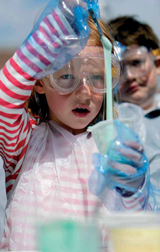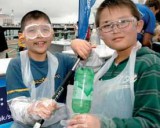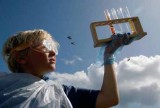Science is a source of fascination for pupils and by setting up an after-school club you can give them the chance to enjoy the subject's cre
STEM (Science, Technology, Engineering and Maths) Clubs provide the perfect opportunity to get pupils excited about the possibilities of these subjects beyond the constraints of timetables and tests. By creating a stimulating environment for children to explore STEM, you can help to build their confidence, realise their potential and have a lot of fun along the way.
 Whether you’re bursting to start a club or have been newly appointed as STEM coordinator at your school, the good news is that there are plenty of resources and lots of support out there to get you started.
Whether you’re bursting to start a club or have been newly appointed as STEM coordinator at your school, the good news is that there are plenty of resources and lots of support out there to get you started.
Setting up a STEM Club can be approached like planning a lesson or project (but without the dreaded pile of marking at the end). It’s a good idea to consider why you want to set up a club and what your objectives are: will the club be inclusive of all pupils who are interested and enthusiastic, or will the focus be for those who have shown an aptitude for STEM during lessons? Will your club be themed (for example, engineering or astronomy) or would you like to take a crosscurricular approach?
If you hadn’t even thought of the options above: don’t panic! All you need to do is STEM…
The STEM Clubs Network aims to provide teachers with access to professional support, including opportunities to attend free training and networking sessions. With over 2,500 UK schools affiliated to the network, a range of tried and tested activities are now available online. Register for free to receive practical advice and words of encouragement from teachers just like you who have been there, done that and have the lab coat to prove it.
Try running the club with support from at least one other colleague, as this will lighten your preparation workload and often improve the variety of activities you can offer. Why not try teaming up with a teacher from another department to create a cross-curricular activity? A club leader and science teacher at Boundary Primary School, Blackpool asked their geography teacher to get involved when planning their Global Renewables Education Programme project.
If parents see that you are willing to dedicate extra time to encouraging their children in STEM, they are more likely to respond with valuable help - including time and fundraising support.
Offering parents regular or occasional opportunities to take part in your STEM Club is a great way of encouraging students to see the real-life applications of STEM and dispel myths that science or maths are difficult - after all, it can’t be that tough if mum or dad can manage it.
When setting up their STEM Club, teachers at Aslacton Primary School, Norfolk, asked pupils to fill in a simple questionnaire about activity ideas for the club (be warned, most will likely involve blowing things up or chopping). This technique benefits you by creating a bank of project ideas and also gives the students a vested interest in the club, which will increase their enthusiasm and dedication towards taking part.
 Organisations including STEMNET, British Science Association and Young Engineers coordinate a number of national schemes which are designed to engage students in science, technology, engineering and maths. Many of these programmes, including project awards (CREST) and role-model schemes (The STEM Ambassadors Programme), are managed at a local level by regional officers who can offer support on how to make the most of enriching activities at your club.
Organisations including STEMNET, British Science Association and Young Engineers coordinate a number of national schemes which are designed to engage students in science, technology, engineering and maths. Many of these programmes, including project awards (CREST) and role-model schemes (The STEM Ambassadors Programme), are managed at a local level by regional officers who can offer support on how to make the most of enriching activities at your club.
In light of the variety of programmes in place to support your Clubbing mission, thanks to Government aims to establish a STEM Club in each school throughout the UK, it’s never been a better time to get involved. As a club leader you will find that nothing quite beats the sense of achievement, fun and amazement they can create for pupils - and you might just learn something new along the way.
• stemnet.org.uk (Use the interactive regional map to find your local contacts)
• britishscienceassociation.org/ web (For information on the award schemes and national events)
• stemdirectories.org.uk (A database of STEM activities)
Local businesses are likely to be interested in getting involved with your STEM Club as it can improve their reputation in the community, support CSR initiatives and create a fun environment for employees. Why not hold a lunchtime or evening networking event at your school, inviting local business leaders along to discuss opportunities to work together at your club? Invites could be circulated amongst parents, many of whom may be employed by the companies you need to speak to.
 So now you’ve got the methods to set up your STEM Club, you need the all important ingredients: activity ideas. Here are a few experiments to whet your members’ appetites.
So now you’ve got the methods to set up your STEM Club, you need the all important ingredients: activity ideas. Here are a few experiments to whet your members’ appetites.
STEM Club:Monteney Primary School, Sheffield
Activity: Fun things that fly
A theme which ran across a term with pupils taking part in the following activities: Designing and making windmills, aeroplanes and kites; collecting feathers and learning how wings work in flight; making hot air balloons and testing what they can carry.
STEM Club: Cypress Junior School, Croydon
Activity: Fizzing bath bombs
The chemistry behind bath bombs and why they fizz. Pupils experimented with different recipes, adding scents and colourings to a variety of moulds.
STEM Club: Fishergate Primary School, York
Activity: The Smartie way to exercise
For a food and health session, pupils used maths and physics to work out how many calories were in a Smartie and how many laps of the playground they would need to run to work it off. N.b. a tube of Smarties is essential!
STEM Club: Wyche C of E Primary School, Malvern
Activity name: Lights, camera, STEM!
This design and technology session saw pupils making pinhole cameras, flick-books and watching online resources in order to consider how animations might be made.
Behaviour management: choosing the right words
Behaviour Management
Use the bottle-flipping craze to create good school behaviour, not bad
Behaviour Management
